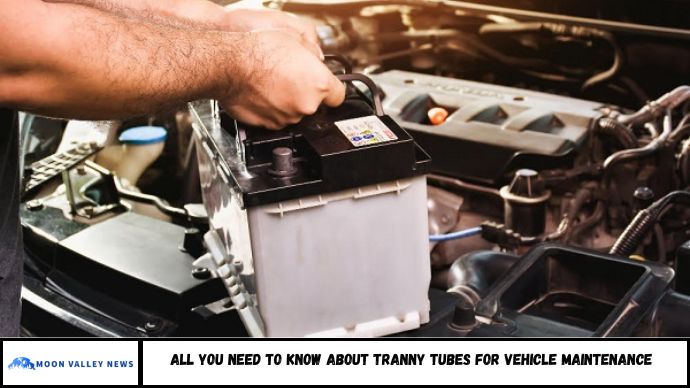Tranny tubes, also known as transmission dipstick tubes, are essential for monitoring and maintaining your vehicle’s transmission fluid. These small yet critical components allow access to the dipstick, help prevent fluid contamination, and assist in keeping your transmission operating efficiently. This article covers what tranny tubes are, how they function, signs of wear, how to install or replace one, and tips to maintain it—all in one complete guide.
Introduction: The Most Overlooked Component in Your Transmission System
You regularly check your oil, rotate your tires, and change air filters—but when was the last time you inspected your tranny tube?
Often overlooked, this small tube performs a big job. It ensures that transmission fluid can be easily checked and properly maintained. A cracked or loose tranny tube could lead to fluid leaks, contaminated transmission systems, or even complete failure of the transmission.
In this guide, you’ll discover:
- What a tranny tube is and how it works
- Types and materials used
- How to spot a failing tube
- How to install or replace one
- Maintenance and troubleshooting tips
- Common FAQs
1. What Is a Tranny Tube and What Does It Do?
A tranny tube is a narrow metal or rubberized tube connected to an automatic transmission system. It houses the dipstick, which is used to check transmission fluid levels and condition.
Main Functions of a Tranny Tube:
- Guides the dipstick to the transmission fluid reservoir
- Seals the system, preventing dirt and debris from entering
- Provides access for adding or replacing transmission fluid
- Supports accurate fluid readings, essential for optimal performance
2. Why Tranny Tubes Matter: The Role in Transmission Health
The transmission system is one of the most expensive parts of your vehicle. Overheating, fluid loss, or contamination can quickly cause serious damage.
Tranny tubes help avoid these issues by:
- Providing a clean entry point for checking and adding fluid
- Preventing air leaks or fluid evaporation
- Helping detect early signs of transmission trouble
Without a properly functioning tube, transmission fluid levels can’t be monitored reliably—putting your entire drivetrain at risk.
3. Types of Tranny Tubes: Choosing the Right One
There are several types of tranny tubes available, and selecting the right one depends on your vehicle and your usage style.
A. OEM (Original Equipment Manufacturer) Tubes
- Specifically designed for your make and model
- Offers perfect fit and reliable performance
- Ideal for stock vehicles
B. Aftermarket Tubes
- Offer flexibility and customization
- Often feature adjustable or universal fittings
- Good for modified or performance-focused vehicles
C. Braided Steel or Heavy-Duty Tubes
- Made to withstand high temperatures and vibrations
- Designed for racing or heavy hauling
- Typically more expensive but highly durable
D. Flexible Rubber or Silicone Tubes
- Easy to install in tight engine bays
- Best for custom builds or hard-to-reach transmission ports
When replacing your tube, always ensure it matches your transmission model and fluid type.
4. Signs Your Tranny Tube May Be Failing
Just like hoses and gaskets, tranny tubes can wear out over time. Early detection can prevent major damage.
Warning Signs to Watch For:
- Visible transmission fluid leaks around the dipstick tube
- Loose dipstick that wiggles or falls out
- Cracks or rust on the tube surface
- Difficult dipstick insertion or removal
- Transmission slipping or overheating
If you notice any of these signs, it’s time to inspect or replace the tube.
5. How to Replace or Install a Tranny Tube: Step-by-Step Guide
You don’t always need a mechanic. Replacing a tranny tube is a manageable DIY task for many car owners.
What You’ll Need:
- Replacement tranny tube
- Transmission dipstick (if not included)
- Rubber O-ring or seal
- Basic hand tools (wrench, screwdriver)
- Funnel and transmission fluid
- Gloves and rags
Step 1: Prepare the Vehicle
- Park on a level surface
- Allow the engine to cool
- Use jack stands if necessary
Step 2: Remove the Old Tube
- Remove the dipstick
- Locate the mounting bracket or bolt securing the tube
- Use a wrench to unbolt it
- Gently pull the tube out—twist slightly if needed
Step 3: Clean the Port
- Wipe the area around the hole
- Remove any old sealant or debris
Step 4: Install the New Tube
- Apply a new rubber seal or O-ring at the base
- Slide the tube into the transmission port
- Re-bolt the mounting bracket securely
Step 5: Refill and Test
- Use a funnel to add transmission fluid if needed
- Reinsert the dipstick
- Start the engine and let it warm up
- Check the fluid level and inspect for leaks
Installation usually takes 30–60 minutes and can prevent major transmission issues down the road.
6. Maintenance Tips to Extend the Life of Your Tranny Tube
A properly installed tranny tube should last for years—but regular checks will keep it in top shape.
Best Practices for Tranny Tube Maintenance:
- Inspect monthly for signs of rust, wear, or leaks
- Check dipstick fitment—it should feel snug, not loose
- Clean dipstick before reinserting to avoid contamination
- Replace seals or O-rings any time the tube is removed
- Use manufacturer-approved transmission fluid
- Tighten mounting bolts during routine maintenance checks
Regular inspection during oil changes can catch problems early and save you time and money.
7. Common Tranny Tube Problems and How to Fix Them
Despite being a small component, tranny tubes can cause big headaches if neglected. Here’s how to troubleshoot common issues:
A. Fluid Leaking from the Base
- Cause: Worn or damaged seal
- Fix: Replace the rubber O-ring and reinstall with proper sealing
B. Dipstick Pops Out While Driving
- Cause: Excess pressure or incorrect installation
- Fix: Check fluid level; reinstall dipstick correctly
C. Tube Is Bent or Cracked
- Cause: Age, impact, or engine vibration
- Fix: Replace tube with a new one—preferably a heavy-duty version
D. Fluid Reading Inaccurate
- Cause: Dipstick not reaching correct fluid level
- Fix: Verify correct tube length for your vehicle
Addressing these issues promptly can prevent serious damage to your transmission.
8. Benefits of Maintaining a Proper Tranny Tube
- Accurate fluid readings for better vehicle performance
- Prevention of leaks and contamination
- Longer transmission lifespan
- Better fuel economy and smoother shifting
- Reduced risk of costly repairs
A well-maintained tranny tube is a simple, affordable way to protect your investment.
9. Tips for Selecting the Right Tranny Tube
When buying a replacement, consider:
- Vehicle make, model, and year
- Transmission type (automatic/manual)
- Length and curvature of the original tube
- Material (steel, flexible rubber, braided)
- Seal compatibility with your transmission pan
Bringing the old tube to the auto parts store can help ensure a perfect match.
Frequently Asked Questions (FAQs)
1. What is a tranny tube used for?
It houses the dipstick and allows you to check and refill transmission fluid safely.
2. Can I drive with a broken tranny tube?
No. It may lead to fluid loss, overheating, and damage to the transmission.
3. How do I know if my tranny tube is leaking?
You may see fluid around the base of the tube or notice drops under your car.
4. Are aftermarket tranny tubes safe to use?
Yes, if they match your vehicle’s specifications and are installed correctly.
5. How often should I check the dipstick and tube?
Check once a month or every 1,000 miles, especially if you drive long distances.
6. Do all cars have a transmission dipstick tube?
Most automatic vehicles do, though some newer models use sealed systems.
Conclusion
While often ignored, the tranny tube is a crucial part of your vehicle’s transmission health. Regular inspection, proper installation, and timely replacement can help prevent serious mechanical issues and save you from costly repairs.







